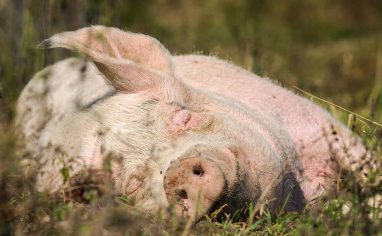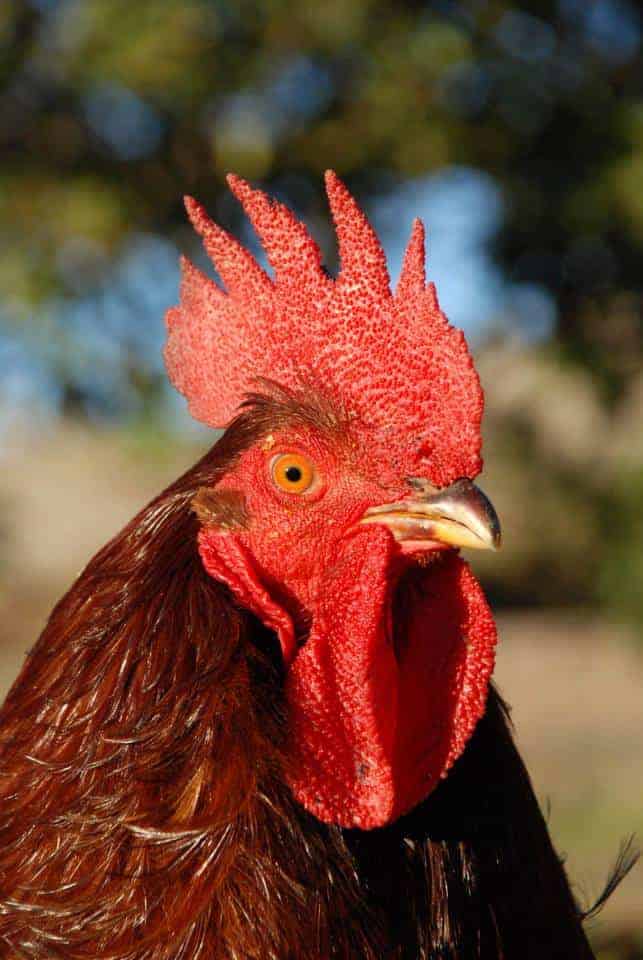
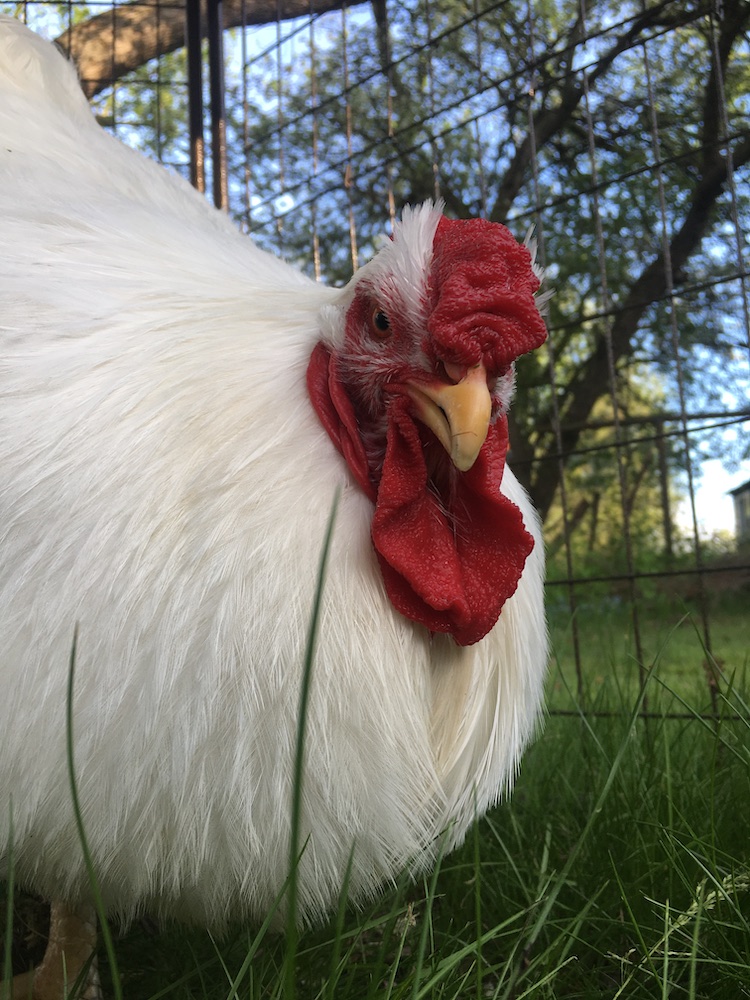
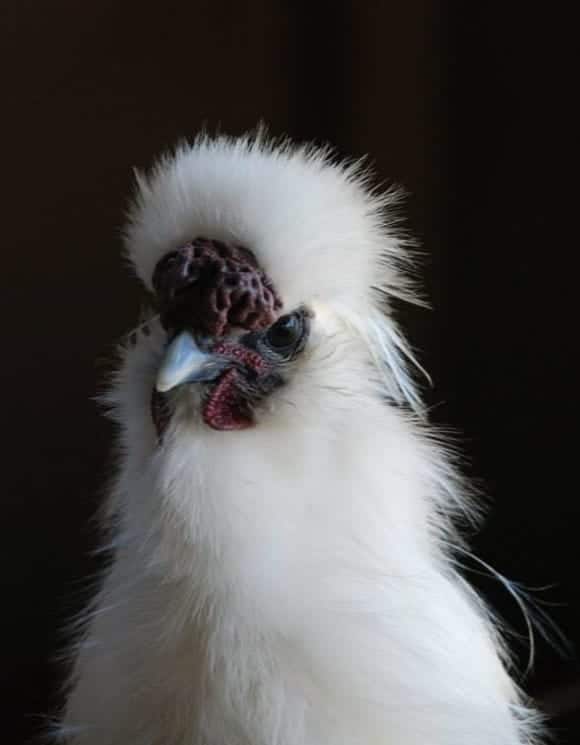
This resource has been updated as part of the veterinary review process. It was originally published on March 29, 2022.

Veterinary Review Initiative
This resource has been reviewed for accuracy and clarity by a qualified Doctor of Veterinary Medicine as of June 5, 2023. Check out more information on our Veterinary Review Initiative here!
If you’ve spent much time looking through our offerings, you likely know the important role routine health checks play in keeping residents healthy and catching signs of concern early. Performing health checks regularly is imperative, but this should not be the only tool you use to monitor your residents’ health and well-being. The importance of thoughtful daily observation cannot be overstated. While some issues may be difficult to detect without a hands-on evaluation, there are other potential signs of concern that could be missed during a health checkThe Open Sanctuary Project uses the term "health check" to describe health evaluations performed by caregivers who are not licensed veterinarians. While regular health checks are an important part of animal care, they are not meant to be a replacement for a physical exam performed by a licensed veterinarian., particularly those that manifest as slight changes in behavior or activity. By incorporating both daily observation and routine health checks into your care protocols, you are more likely to catch issues that develop in the period between health checks, as well as issues that are unlikely to be detected without a hands-on evaluation.
When it comes to daily observation, the keyword is “thoughtful”. Daily observation of residents must be more than just looking at them. Anyone caring for an animal, regardless of their species or breed, should be trained to observe the individuals in their care for behaviors and physical signs that are abnormal for the species, keeping in mind issues that are common in a particular species or breed and their warning signs. Of equal importance is getting to know the individuals being cared for and watching for things that are out of the ordinary for that particular individual. To read more about refining your observation skills, check out our resource here.
Familiarize Yourself With “Normal”
In order to identify signs of concern, it’s helpful to first consider how a healthy chicken typically looks and acts. While all chickens are unique individuals, there are some general characteristics that most healthy chickens will present. However, as you’ll see below, there is going to be some variation depending on breed. And as we mentioned above, it’s important to learn what is “normal” for each individual in your care.
With that in mind, in general, a healthy chicken should:
- Be bright and alert (they do take naps during the day, but should be easily roused)
- Have a bright red comba fleshy crest on the head of the domestic chicken and other domesticated birds and wattles – be aware that there are some breeds of chickens who have a naturally darker comb and wattles such as Ayam Cemanis and Silkies (photo above on right)
- Have an upright comb, unless it is normal for a particular individual to have a slightly floppy comb – this applies mostly to individuals with a single comb (photo above on left) or carnation comb
- Have clear, bright eyes
- Have smooth, flat feathers (with the exception of Silkies, chickens who have naturally frizzled feathers, or chickens who are molting)
- Walk with an even gaitA specific way of moving and the rhythmic patterns of hooves and legs. Gaits are natural (walking, trotting, galloping) or acquired meaning humans have had a hand in changing their gaits for "sport".
- Have clean feathers on their bum (it is not uncommon for Cornish crosses and other large breedDomesticated animal breeds that have been selectively bred by humans to grow as large as possible, as quickly as possible, to the detriment of their health. chickens to have slightly dirty feathers under the vent)
- Have a healthy appetite. Please note that large breed chickens, and particularly Cornish crosses, should be very excited to eat.
Chicken Droppings
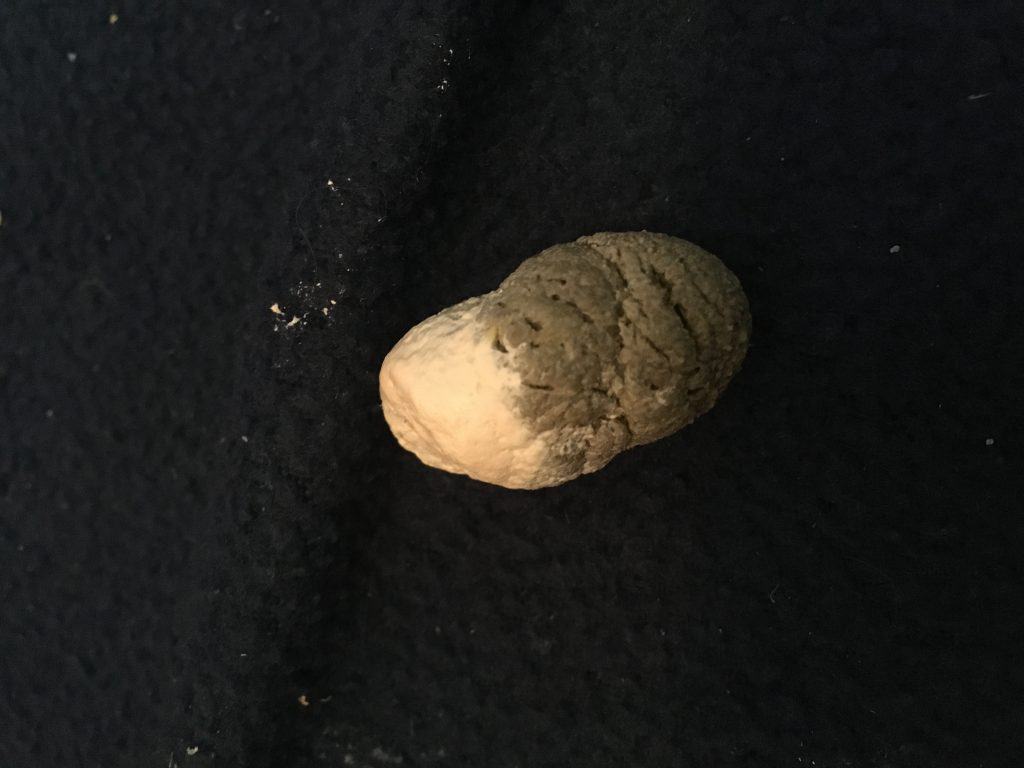
In addition to knowing what a healthy chicken looks like, it’s also important to know what healthy chicken droppings look like. Many people are surprised to learn that there is an incredibly wide range of normal when it comes to chicken poop. Therefore, it’s important to familiarize yourself with what is normal for the chickens in your care so you can notice if something seems unusual.
Chickens do not urinate like mammals do. They produce urates, which mix with the waste produced by the digestive tract in the cloaca. Therefore, most chicken droppings will be a combination of digestive and urinary waste. The white portions of a chicken poop are the urates, with the rest being the feces.
The color and consistency of chicken poop can be a great indication of the overall health of the chicken. The most common colors of chicken poop are some shade of brown, gray, or green, but the color of fecal matter can be affected by diet. For example, chickens eating red fruits may have some red-tinged poop, which may be confused with blood.
Chicken droppings are typically soft, but formed, though it’s not uncommon for large breed chickens to have looser stool than non-large breedA domesticated animal breed that has not been specifically engineered to grow as quickly as possible for the purpose of human consumption. In resources at The Open Sanctuary Project, "Heritage" breeds of turkeys, for instance, are "non-large breed", even if they are physically quite big. chickens. Additionally, chickens who are eating lots of water-dense foods or are drinking more than usual (which is common when temperatures are hot) may also have loose stool. For the most part, healthy chicken poop does not have an overwhelming odor, with the exception of cecal poop or broodyTerm used to describe a hen demonstrating behavioral tendencies associated with sitting on, incubating, and protecting a clutch of eggs, but a hen can be broody even if her eggs are removed. hen poop (described below).
Cecal Poop
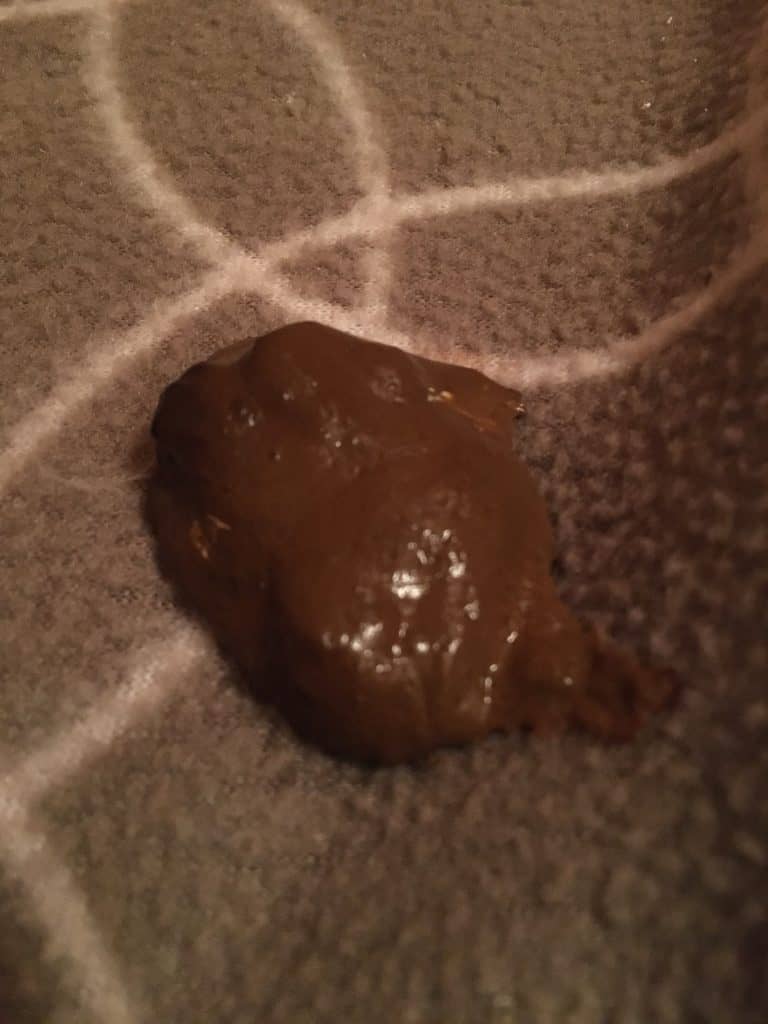
Many new chicken caregivers find themselves in a state of panic when they see their first cecal poop, because they don’t recognize it as normal. As part of the digestive process, food matter is fermented by bacteria in the ceca. The ceca empty their contents a few times per day, and cecal poop looks (and smells) much different than other chicken droppings. Cecal poop is typically very malodorous. It has a much looser consistency – similar to pudding – and often does not contain urates. Cecal poop is often a dark shade of brown or mustard-yellow.
Broody Hen Poop
A broody hen will spend the majority of the day nesting. Because of her dedication to nesting and her desire to keep her nest clean, she will often “hold it” rather than pooping frequently throughout the day, and may only leave her nest a couple of times to relieve herself. Because of this “back-up” of waste materials, it is not uncommon for a broody hen to produce surprisingly large, pungent droppings.
Potential Signs Of Concern
Now that we’ve got an idea of what is “normal”, let’s look at potential signs of concern. As prey animals, chickens will often hide any signs of illness or injury until they are no longer able to do so. This means that once you notice something is obviously wrong, the issue may have been festering for quite some time. Therefore, in order to catch and respond to health issues as soon as possible, it will be important to recognize the more subtle signs that something may be amiss.
As such, it’s important to get to know the individuals in your care so you can recognize when they are not acting like themselves. Caregivers who really spend time getting to know their residents in terms of their personality, typical behaviors, physical characteristics, and routines can sometimes catch when something is wrong before there are clear signs of illness or distress. Sometimes it’s something as simple as an individual sleeping away from their friends or not running up to greet you as they normally would. Any time you notice a change in an individual’s normal routine, it’s a good idea to perform a health check and keep a close eye on them.
While not an exhaustive list, during your daily observation of your residents, be on the lookout for the following:
Changes in their posture, gait, mobility, or activity level, such as…
- Consistently holding their head in an unusual position, including tilted to the side or looking straight up
- Standing very upright like a penguin or hunching with a tucked tail or head
- Drooping wing(s)
- Limping, consistently standing on one leg, walking with a “drunk” appearance, or any other abnormal gait
- Sitting more than usual, weakness, or reluctance/inability to stand
Changes to their physical appearance, such as…
- Ruffled or puffy feathers – this plus closed eyes is the classic “sick chicken” stance, though a chicken who is cold will present in the same way.
- Nasal and/or ocular discharge
- Swelling around the eyes
- Swelling, scabbing, or discharge of the toes, feet, or hocks
- Changes in color of the comb or wattles including being paler than usual, darker than usual, or developing areas of discoloration
- An abnormally large cropA crop is a pouched enlargement of the esophagus of many birds that serves as a receptacle for food and for its preliminary maceration. or a full crop before having access to food
- Fecal matting or pasting under the vent (some dirty butt feathers are not uncommon in large breed chickens)
- Distension of the abdomen
- Swelling of the head or unexplained scabbing or growths on the face or head
- Broken or damaged feathers – damaged feathers on wing tips could indicate that the individual is using their wings for support while walking or standing, and hens who have damaged feathers on their back or hips could be suffering from over-mounting and could be hiding a nasty wound.
Changes in behavior such as…
- Hiding more than usual
- Isolating themselves from the flock
- Changes to egg laying in actively laying hens, including an unexpected stop in laying, laying abnormal eggs, or passing “lash eggs”
- Changes to their routines, including changing when or where they sleep
- Behaving differently than they normally do
Changes to their eating and drinking such as…
- Refusal to eat or a decrease in appetite – be aware that chickens may peck at food without actually eating. If you are unsure if someone is eating well, you should monitor their crop.
- Drinking excessively or drinking less than usual
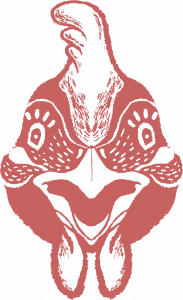
Large Breed Chicken Not Eating Well?
While a decrease in appetite is concerning in all chickens, because of their voracious appetites and the fact that they often continue eating despite not feeling well, if a large breed chicken does not want to eat, this is a huge red flag and warrants immediate assessment.
Other things to watch for include…
- Sneezing, coughing, wheezing, wet-sounding breathing (gurgling), or other abnormal breathing sounds
- Labored breathing, open-mouth breathing (open-mouth breathing can also be a sign a chicken is too hot), or severe tail bobbing
- Gasping with an extended neck
- Unusual odors, such as a strong, foul, sour, or cheesy odor
- Signs of being bullied
- Changes in vision or appearance of the eye, including a sudden loss of vision or an abnormal pupil
If you see any of the signs above or anything else out of the ordinary, be sure to investigate further and consult with your veterinarian as needed. Depending on the severity and whether or not there are multiple signs of concern, the individual may need to be seen by a veterinarian immediately. In some cases, conducting a health check, either in full or in part, can help you to gather more information about the individual to share with your veterinarian so they can help determine the best course of action. However, in some instances, further handling is not advised, such as if the individual is showing signs of respiratory distress or shock.
Unusual Droppings
As we discussed earlier, there is a wide range of normal when it comes to chicken poop. Not every unusual dropping is cause for immediate concern, but if you see any of the issues described below, be sure to consult with your veterinarian to determine the underlying cause and best course of action. Some gastrointestinal disease processes that affect chickens are zoonotic, meaning they can be transmitted from the chicken to humans. Therefore, it is important to always wear gloves when working with chickens who are passing abnormal droppings.
When observing your residents’ droppings, keep an eye out for:
- Bloody droppings
- Worms (please note that the absence of visible worms does not mean the individual does not have parasitic worms or other parasitic infection)
- Consistently foamy, loose or abnormally colored droppings that cannot be explained by diet
- Watery droppings from a chicken who looks unwell
- A decrease or stop in fecal production – if you notice that a resident is not pooping or is only passing clear liquid without any fecal matter, this could indicate an obstruction. Contact your veterinarian immediately. An ultrasound may be necessary in order to make a diagnosis.
In the beginning, it can be overwhelming figuring out what is normal and what is cause for concern, but chickens poop a lot, so you’ll get plenty of opportunities to familiarize yourself with the wide range of normal poop! If you have concerns about a certain individual and their poop, contact your veterinarian and submit a sample for diagnostic testing. Similarly, if you are unsure if what you are seeing is cause for concern or not, it’s a good idea to collect a fecal sample and reach out to your veterinarian.

Now that you have an idea of what to look for, be sure to build thoughtful daily observation into your caregiving routine if you haven’t already! The more you observe your residents, the better you’ll become at differentiating between “normal” and potentially concerning. When in doubt, contact your veterinarian for guidance.
Infographic
Signs Of A Healthy Chicken Resident by Amber D Barnes
SOURCES:
Physical Exam One Page Guide | Chicken Run Rescue
Physical Examination Of Backyard Poultry | The Merck Vet Manual
Chicken Poop Guide | The Chicken Chick (Non-Compassionate Source)






